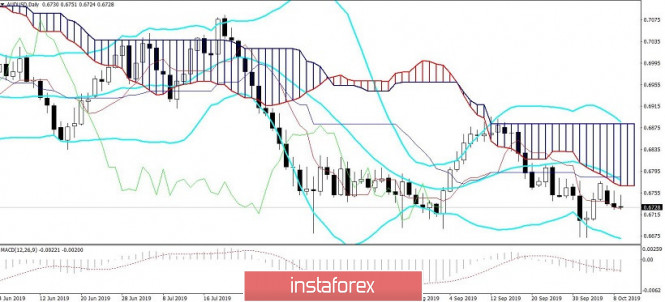The Australian dollar, like its American namesake, completely focused on waiting for the outcome of negotiations between the US and China, which should start tomorrow, October 10. The aussie's reaction is expected to be as volatile as possible, since China is Australia's main trading partner. In this context, the prospects for the US dollar are not so clear: in the event of a negotiation failure, the greenback, on the one hand, will be under pressure from the dovish intentions of the Federal Reserve, but, on the other hand, can take advantage of the status of a defensive instrument, as it was during the last escalation trade war this summer. But the fate of the Australian currency in the event of a negative scenario is quite predictable.
I recall that at the last meeting, the Reserve Bank of Australia lowered the interest rate by 25 basis points. This is the third rate cut this year: the regulator first resorted to easing monetary policy this summer, right after the next round of the trade war. However, this factor played an important, but not decisive role. Since February, rumors have been circulating in the market that the Australian central bank will have to resort to incentive measures amid ongoing global conflict and a slowdown in the global economy.

The hypothetical intentions of the regulator took on a distinct form after the publication of key macroeconomic data. First of all, the growth dynamics of the Australian economy was disappointing: the GDP indicator has been consistently and steadily declining over the course of four quarters since the beginning of last year. This year the situation only worsened: in the second quarter, the key indicator fell to multi-year lows, that is, around 1.4%. Other indicators, in particular labor market data, are also controversial. For example, the unemployment rate, on the one hand, is at low values, and the overall growth rate of the number of employed people is consistently coming out of the "green zone". However, the structure of this release suggests that the increase in the number of employees is due only to part-time employment. But full employment shows a negative trend, collapsing into a negative area.
All this suggests that AUD/USD traders should not expect a breakthrough in inflationary growth in the near future, in particular due to the fact that part-time work implies a lower level of wages. There is another cause for concern: we are talking about the indicator of confidence in the business environment from NAB (National Australia Bank). According to analysts from the largest Australian bank, consumer confidence fell to zero in September. This is despite the fact that over the past four months the figure has been consistently and quite rapidly declining. This result is due to the difficult relations between the United States and China, as well as a decrease in the commodity market (primarily iron ore).
In other words, traders should prepare for the next round of interest rate cuts. Firstly, the head of the Reserve Bank of Australia, Philip Lowe, hinted at this. He made it clear that the regulator is ready to continue to respond to the decline of key indicators, "playing ahead of the curve". Lowe did not push himself and his colleagues into any time frame, but the market is confident that by the end of the year the RBA will still lower the rate to 0.5%. In the framework of 2019, two more meetings will be held - November 5 and December 3. According to the general expectations of traders, the actions of the regulator will depend on the results of the US-Chinese negotiations. If they fail, then with a high degree of probability the rate will be reduced in November. Otherwise, the corresponding decision will be made at the December meeting, taking into account the dynamics of key macroeconomic indicators.
It is worth noting that Philip Lowe is skeptical of incentive programs (which are adopted by, in particular, the Bank of Japan and the ECB), therefore, the Australian central bank will respond to external challenges only by reducing rates. Thus, the focus of the AUD/USD traders is still on the US-Chinese trade negotiations, on the outcome of which, in fact, depend on the prospects of the monetary policy of the RBA.

If the outcome is positive, the pair can impulsively jump to the resistance level of 0.6880 (the upper boundary of the Kumo cloud, which coincides with the upper line of the Bollinger Bands indicator on the daily chart). But the main goal of the upward movement will be the mark of 0.7000 - only when it is overcome can we talk about a trend reversal. But if the parties again disperse "in the corners of the ring" without any agreement, the aussie can again test the lows of this year, dropping to the area of 0.6670, that is, to the lower line of the Bollinger Bands indicator on D1.
The material has been provided by InstaForex Company - www.instaforex.com